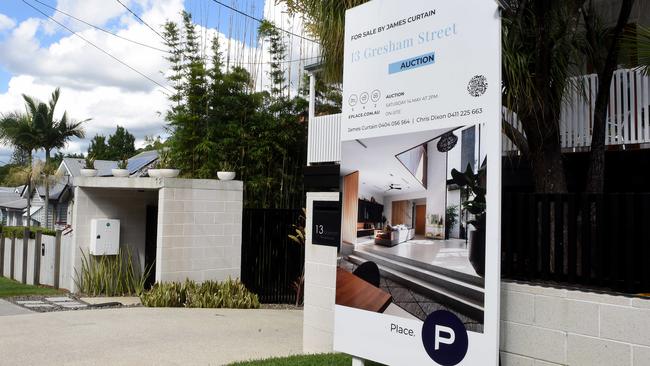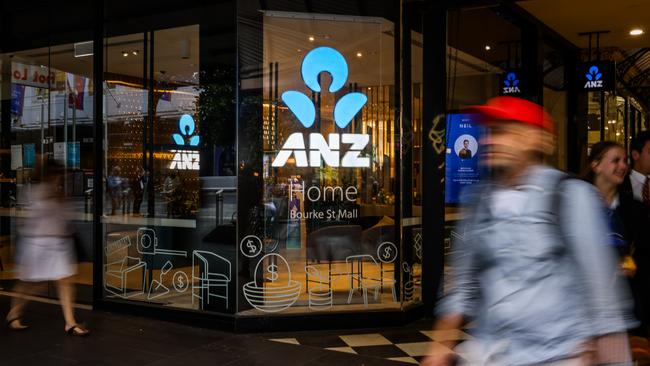ANZ boss Shayne Elliott says we don’t need to fear interest rate hikes
After two years of Covid turmoil, this bank boss says Australia’s shift into recovery mode will mean an economic environment not seen for decades.

After two years of Covid turmoil, Australia’s shift into recovery mode will represent a very different and potentially challenging economic story for millions of borrowers who have never experienced a rapid round of interest rate rises.
But ANZ chief executive Shayne Elliott says while it is going to hurt some, he is confident his customers have nothing to fear. They are well placed to absorb the looming interest rate spike “relatively comfortably”.
He was speaking as the Reserve Bank this week lifted the cash rate by 25 basis points and warned of more to come as it attempts to reel in inflation raging through the economy. The move represents the first of what is expected to be a string of sharp interest rate rises over the coming year and a half, marking a hawkish pace not seen in more than three decades.
Economists say the cash rate could sit at above 2 per cent by the end of the year, in stark contrast to the ultra-low 0.1 per cent it has been at during the pandemic.
The rises are “quite new for a lot of our customers,” Elliott acknowledges. “Many of our customers have never lived through any of that, whether they’re a small business or they’re a homeowner”.
ANZ wasted no time in quickly passing on the full 25-basis-point rate rise to mortgage customers, joining the other big four banks, including Commonwealth Bank. Higher rates go some of the way to restoring the profit margins that have been pummelled as the cash rate moved close to zero.

Elliott, who has a home lending book of $285bn, points out that more than 70 per cent of his mortgage customers are already ahead on their repayments.
When rates are moving down, customers have to ask their banks to reduce the repayments to the new level. Whether through inertia or an effort to get ahead on a loan, most people simply don’t change repayments.
“That’s 70 per cent of our customers having done exactly that. Now, that means that when their mortgage rate rises next Friday, their repayment isn’t going to change,” Elliott tells The Australian.
Some of these customers are now two years ahead on their mortgage repayments, simply because they left the repayment level untouched as rates were being slashed through the darker days of Covid.
Those who will be more vulnerable are the people who just got their mortgages, because they don’t have that buffer.
“But having said that we do assess people for new loans at today’s rate plus 3 per cent. So we assume that rates are going to go up 3 per cent from where they are,” Elliott says.
This week RBA governor Philip Lowe was talking about a cash rate of 2.5 per cent being a possible target for a so-called “neutral” cash rate.
“Even if the governor is 100 per cent right, we’ve assessed people on the basis of a 3 per cent increase anyway,” Elliott says.
He concedes financial pressures mean things will still have to change for some and house prices may still fall as the property market slows, but there’s a lot of moving parts.
“There will be cost pressures on people, but on the other hand there is also going to be wage inflation as well. And we’re already starting to see that, so people’s income will be going up as well.
“It will be very difficult for some, no doubt. But it’s a relatively modest cohort”.
Elliott was speaking as ANZ delivered a 10 per cent increase in first-half profit to $3.53bn.
The result, for the six months to the end of March, kicks off the last leg of the big bank reporting season, with National Australia Bank to deliver results on Thursday, Macquarie Group on Friday and Westpac on Monday.

ANZ’s first-half dividend was 72c a share, up 2c from the same period last year.
The result was helped by tight cost control and lower charges for bad debts. Indeed, there were $284m in previous provision charges that were released to the earnings line as a recognition “that some of the more acute risks from the pandemic are receding”.
However, the bank still set aside $600m in funds specifically to cover rising risks linked with inflation, interest rates, geopolitical tensions as well as the recent floods in NSW and Queensland.
Meanwhile, Elliott senses a shift. For the first time in recent years, investment spending on growth and technology has outpaced the investment spending needed to keep pace with regulation, compliance and risk.
It’s not a matter of pulling back investment spending, but regulatory programs started since the Hayne financial services royal commission or programs to strengthen anti-money-laundering systems are coming to an end.
Of ANZ’s $1bn investment spend in the June half, 49 per cent was on growth, with 46 per cent on regulation. This time a year ago the split was 53 per cent regulation and 35 per cent growth.
Digital split
Meanwhile, it’s back to the future as ANZ becomes the first of the big four retail banks to remodel its structure while it doubles down on tech investments.
The lender is pushing ahead with plans to separate its banking and non-banking operations under a holding company and is about to submit its final application to regulators.
The move was on trend more than 15 years ago, when Macquarie Group went down this path and the big retail banks also considered pursuing the structure. But the push at the time was to facilitate the bulking-up of their wealth businesses. NAB nearly went for a split, but none of the big banks ultimately pursued it.
The non-operating holding company (NOHC) structure was initially recommended in the 1997 landmark Wallis review into banking as a way to protect depositors from “non-banking” operations such as funds management or life insurance.
The David Murray-chaired financial system review of 2014 was more agnostic about the structure, but saw it more as a useful tool that regulators could use to force on banks taking on too much risk.
Elliott says the structure is needed to build agility into the bank as it pursues more digital investments. While there is no impact on shareholders, this is a way to ringfence the capital needed for its traditional savings business.
The reality is ANZ is playing a major catch-up game in technology following years of under-investment in its ageing systems. A significant loss of mortgage market share during the initial stages of the Covid rush exposed deeper problems in its ability to move quickly.

Macquarie opted for the split during the mid-2000s, essentially carving out its banking business from its fast-growing international funds management business. Suncorp, where insurance generates the bulk of its earnings, also operates under a NOHC structure. Globally, players such as JPMorgan and DBS in Singapore operate under this structure.
ANZ’s board this week signed off on the move, paving the way for the bank to submit a formal application to bank regulator APRA and the Reserve Bank to pursue the split. When approved, that will establish a new holding company that sits below the bank. ANZ’s venture capital arm, 1835i, would be marked as a foundation asset.
By going down the path, which could cost in the tens of millions of dollars to establish, suggests ANZ is planning to make bigger bets on digital to support its ANZ Plus banking transformation. This has already seen ANZ speed up bill payment technology for customers, digital credit cards as well as building out Apple Pay and Android mobile banking technology. It also plans to roll out a digital currency trading platform that is expected to allow customers to trade cryptocurrencies.
“This is an option for the future,” Elliott says. The non-banking group “would allow us to bring the world’s best non-banking tech and services to our customers who take our investments in 1835i, for example, under the new structure.”
He has left the window open to pursuing additional digital acquisitions in the non-operating bank. It could also potentially house ANZ’s property portfolio, including its head office, which is not core to banking.
johnstone@theaustralian.com.au








To join the conversation, please log in. Don't have an account? Register
Join the conversation, you are commenting as Logout